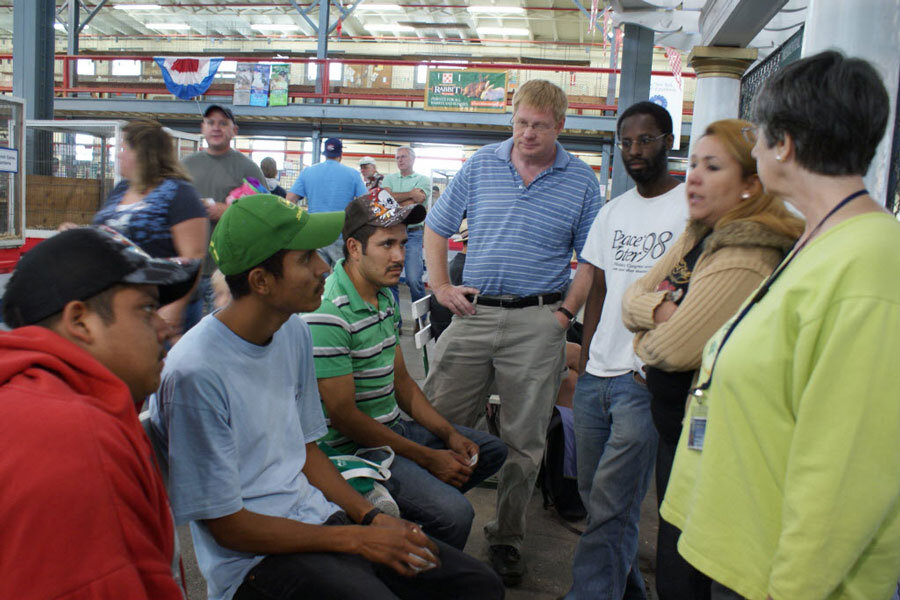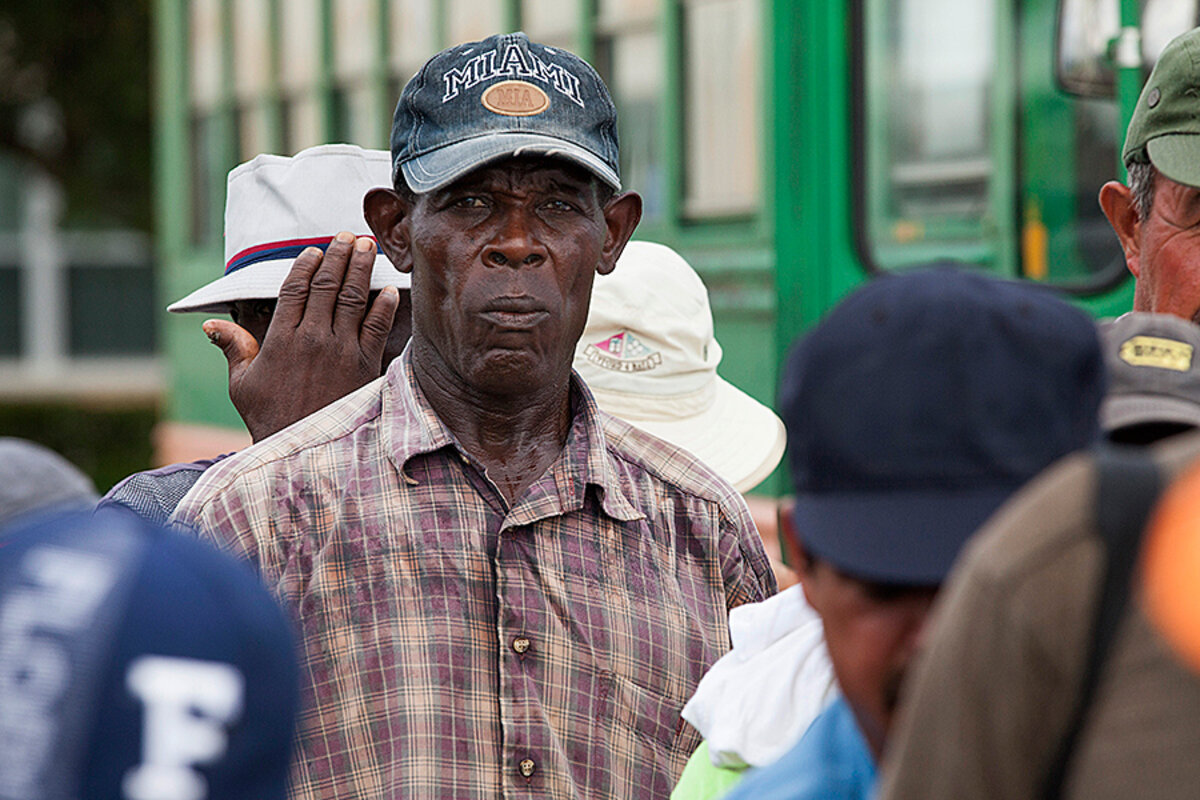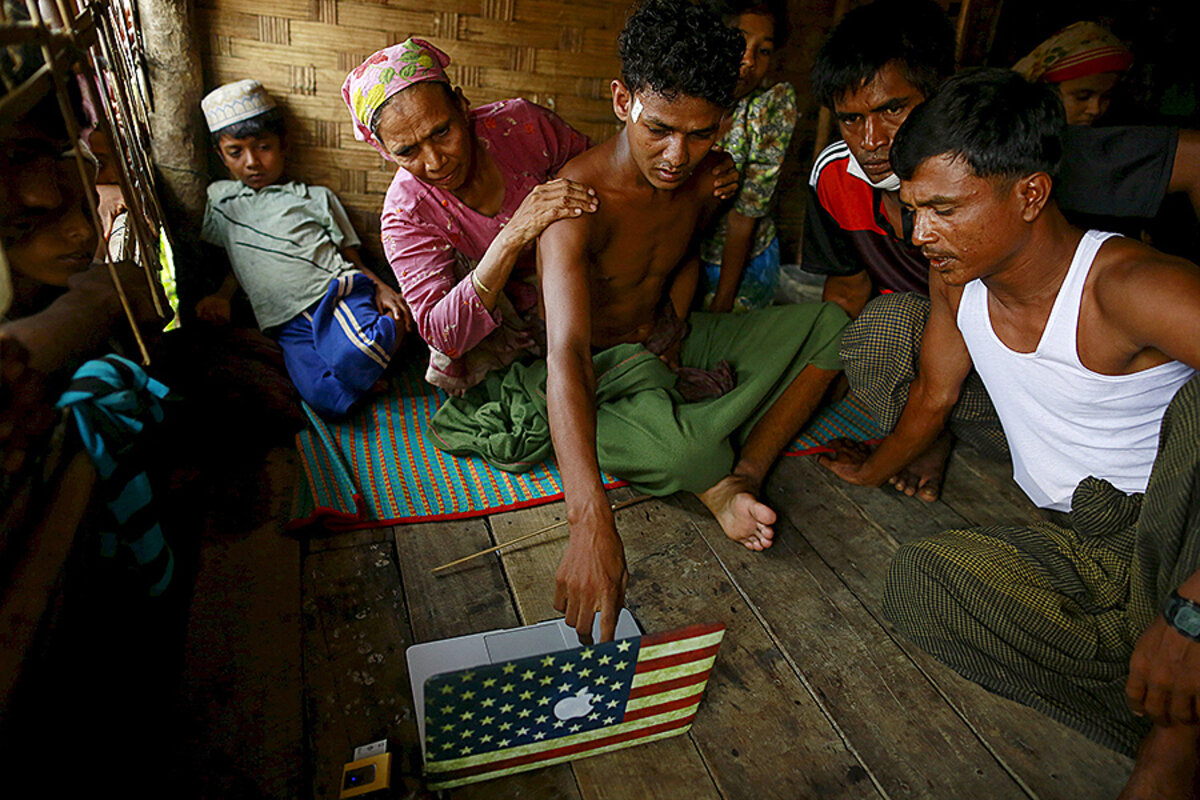Modern slavery: Labor trafficking is everywhere and nowhere
Loading...
This story was written to be viewed on the Monitor's long-form platform.
It was a Friday evening when Renan Salgado received a phone call from an occupational health clinic in Syracuse, N.Y. A group of men had showed up at the medical center a few days earlier, all Mexicans, all malnourished and covered in tick bites. The health staff was worried, and they wanted Mr. Salgado, a human trafficking specialist with the Worker Justice Center of New York, to know about it.
The more Salgado learned – that the five men were scared, that they believed they couldn’t leave their jobs, that they worked for 16 hours a day or more – the more he suspected the men were victims of what policymakers call trafficking, and what he and other advocates call slavery. For the next two days, Salgado stayed on the phone, coordinating a response with law enforcement officers and social workers.
The Mexican men, they had learned, had already left the area with their alleged captors, and were headed to New York City. But the authorities knew right where to intercept them. For these workers were not toiling in an underground sweatshop, or in a remote agricultural field. They had been employees at the 2010 Great New York State Fair, one of the oldest and most popular agricultural festivals in the country, held every year in Syracuse, and were presumably being bused to the next state carnival.
“This case really showed how connected trafficking is to the frame of our economy, to the way we live,” Salgado says. “This was a fair. Everybody loves going to the fair.”
Forced labor, it turns out, is everywhere. Although the problem of human trafficking has sparked political attention over the past decade, the focus in the US – in terms of advocacy, funding, and law enforcement – has been almost entirely on sex trafficking.
But last year, a groundbreaking report from the Urban Institute and Northeastern University suggested what many academics and on-the-ground advocates have long argued: labor trafficking in the US is far more pervasive. It is also far more intertwined with the way we live. There are humans who have been tricked or forced into working for meager wages, often in dreadful conditions, in almost every sector of the economy, from agriculture and domestic work to computer programming and carnivals.
Although many of these workers are, in a sense, invisible – hidden in farm barracks and individual homes – a huge number work in plain sight. They mow grass for landscaping crews, clean dishes in restaurant kitchens, paint toenails in salons and clean hotels and bathrooms – and that is just in the United States. Look globally, where the United Nations' International Labour Organization estimates that some 21 million people are victims of forced labor, and labor trafficking shows up in supply chains for numerous products, from automobiles to electronics to pet food.
It is the breadth of the problem, and how connected it is to the various tentacles of our national and global economy, that makes labor trafficking so difficult to fight. Start to unpack the methods of labor traffickers, and the ways trafficking intersects with our own lives, and one starts to confront the questions and complications of immigration policy, international migration, global inequalities, and, arguably, the American addiction for cheap stuff.
“At the end of the day, if we’re going to talk about labor trafficking, we’re all culpable,” says Bridgette Carr, director of the human trafficking clinic at the University of Michigan Law School. “And nobody’s comfortable with that.”
A hunt for solutions
This may be true. But as a months-long, international Monitor investigation has discovered, there are glimmers of light in this global human rights crisis – a crisis to which we are all connected. From grassroots workers’ coalitions to multilateral treaties and geo-data manipulation to new law enforcement initiatives, individuals are finding new ways to counter labor trafficking.
Some of these efforts have been more successful than others. Some have worked locally, or in particular industries, but not broadly. Some are just building steam, while others have faltered in the face of the huge economic forces that undergird the traffickers’ coercive power. But look at them together, and one sees not only clues for how to counter a pervasive form of exploitation, but also the power of human dignity and hope.
Before delving in to solutions, it’s essential to understand the problem itself, and examine how forced labor became so embedded in everyday American life.
There are no clear statistics on the number of labor trafficking victims in the US since the nature of the crime is that workers’ situations are hidden and manipulated. The range offered by advocates is from hundreds of thousands to, at the upper end, millions of individuals. For its part, the ILO estimates 1.5 million victims of forced labor in North America and Europe. More fine-tuned research from smaller areas have found numbers that seem to support that estimate. One study from San Diego County, Calif., for instance, estimated that 38,500 undocumented Spanish-speaking migrants were victims of trafficking in that municipality of about 3.2 million.
A carnival job for meager pay
The case of trafficking at the New York State Fair is in many ways emblematic.
According to court papers and advocates who worked on the case, the five men serving gyros and taking down carnival rides came to the US on temporary guest worker visas. They had been in Mexico in 2010 when a labor recruiter came to town looking for people to work in the carnival industry. The men signed a contract that promised them more than $10 an hour, as well as room and board, and the recruiter helped them secure H2-B visas.
But once they got to the United States, it turned out that they had to sleep nine or 10 men to a bug-infested trailer. They received one meal a day. And when they got paid at all, they received $1 or $2 an hour. Their boss, they said, threatened that they would be arrested and deported if they tried to quit. Eventually Salgado’s organization filed a lawsuit on the workers’ behalf that led to a settlement under which the vendor agreed to give the workers their back pay.
All of this, except the successful lawsuit, is a typical situation for labor trafficking victims in the US, advocates say.
Most trafficked workers – 71 percent, according to the 2014 Urban Institute report – arrive in the US as part of a temporary work program. There are a number of different such programs in the US and most, in theory, provide workers for jobs when there are no American workers available. One requirement of these temporary visas is that people remain employed – tying their legal status to their employers.
“This puts workers at a huge vulnerability,” says Colleen Owens, an author of the 2014 Urban Institute report. “There is a very real fear of being in the US without lawful status. That is exploited by employers over their workforce. They threaten that [workers] would be deported or arrested if they try to leave.”
In 2000, Congress established a special visa for human trafficking victims, which was supposed to protect people in this situation. But Urban Institute researchers found few of these visas are actually given, and that many trafficking victims end up jailed or in deportation proceedings. Meanwhile, temporary work programs are increasingly popular in destination countries for migrants, from Canada to Dubai to Singapore.
“It’s been a way for governments to address the desire for cheap labor, malleable labor, but then not have to deal with any of those people's families,” says Neha Misra, senior specialist for migration and human trafficking with the international workers’ rights group Solidarity Center, AFL-CIO, based in Washington, D.C. “It’s kind of genius on their part, but it’s devoid of workers’ rights.”
Slavery and sex trafficking in the spotlight
The Victims of Trafficking and Violence Prevention Act, passed by Congress in 2000, was supposed to tighten laws against all forms of trafficking, provide millions of dollars to anti-trafficking law enforcement efforts and create new assistance programs for victims, among other things.
But right away, the focus was exclusively on sex trafficking – a cause that has since gotten a huge amount of celebrity attention, as well as advocacy from an informal coalition of feminist groups, anti-prostitution conservatives and human rights activists.
Part of this, advocates say, is because sex trafficking is in some ways an easier issue; if someone isn’t involved with prostitution, he or she can see themselves as innocent. It fits into a long history of American “white slavery” narratives, according to some historians, whereby whites, and in particular white women, are presented as the main victims of non-white slavers. And it’s more straightforward to find and prosecute, since police already know where to look for illegal prostitution.
Labor trafficking is not only more ambiguous when it comes to our own involvement since almost everyone in the US owns some product likely made with slave labor, it’s also more entrenched. Labor trafficking plays a role in political hot button issues from trade to social security, immigration to local businesses. It is woven into global economies, international business, even the very concept of nationhood.
As Professor Carr, of the University of Michigan, puts it, traffickers use borders as weapons. Although Americans are trafficked within the United States – most often at-risk and runaway youth – the vast majority of victims are migrants. These foreign workers are connected with their US employers through what can be layers and layers of recruiters and subcontractors. Often they take on huge debt to pay recruiting fees, a debt that recruiters enforce, sometimes with violence, back in their home countries. The result is a web of cross-jurisdictional trafficking schemes that makes it difficult to prove who is responsible for the workers’ situation.
“All of these workers are forced to go through recruiters, so there is no strict liability,” Ms. Misra says. “If a labor recruiter does lie to a worker, if the worker takes out huge debt, finds out they’re not making anything, that they’re forced to pay for houses that they’re forced to live in, they still can’t hold the [US] employer accountable.”
The same is true for workers who never make it to the US, but whose labor goes into our everyday essentials: cat food, T-shirts, tomatoes. Across the world, migrants travel from one country to another to find work in any number of sectors, be it housekeeping or forestry or engineering. They are engaged in an outsourced world, where they pay recruiters who place them with contractors who work for other contractors, who eventually send products to the United States.
‘Modern-day slavery’
Although some US companies have taken steps to regulate their own supply chains, even the most committed businesses run into difficulties. In 2011, for instance, executives at the clothing company Patagonia discovered that some of their suppliers in Taiwan were using disreputable labor brokers. These brokers were bringing in what the company suspected was forced labor, and charging those factory workers fees that took almost two years to pay off.
“Paying that kind of money for a factory job is an almost impossible burden for workers already struggling to make a living,” company officials said later. “It creates a form of indentured servitude that could also qualify, less politely, as modern-day slavery.”
Patagonia has since developed a host of stronger migrant worker standards, which it is attempting to enforce throughout its supply chain. But Patagonia is a successful company with a brand emphasis on doing good. Those businesses without a similar corporate desire for a trafficking-free supply chain can easily claim ignorance, advocates say. And ultimately, advocates point out, there is a lot of incentive – on the part of government, businesses, and consumers – to not look too closely.
In 2012, according to the Migration Policy Institute, workers sent some $401 billion in remittances back to their developing countries. In wealthy countries, consumers continue to demand more, cheaper products and services. And migrants, whether in the US or elsewhere, are increasingly willing to risk their lives to earn wages lower than what Americans and others from wealthy countries will accept.
All of this leaves little room for easy answers.
But as Carr says, the first step is to start paying attention. “If this is 99 cents, why is it 99 cents? Are the raw materials not worth very much, or is it the labor?” she says. “There are no easy answers, but once you start to pay a bit more attention, you might start to make those little decisions that, if everyone did them, could make a big difference.”
Coming Nov. 2: One woman's journey from Staten Island slavery to her own boss.










